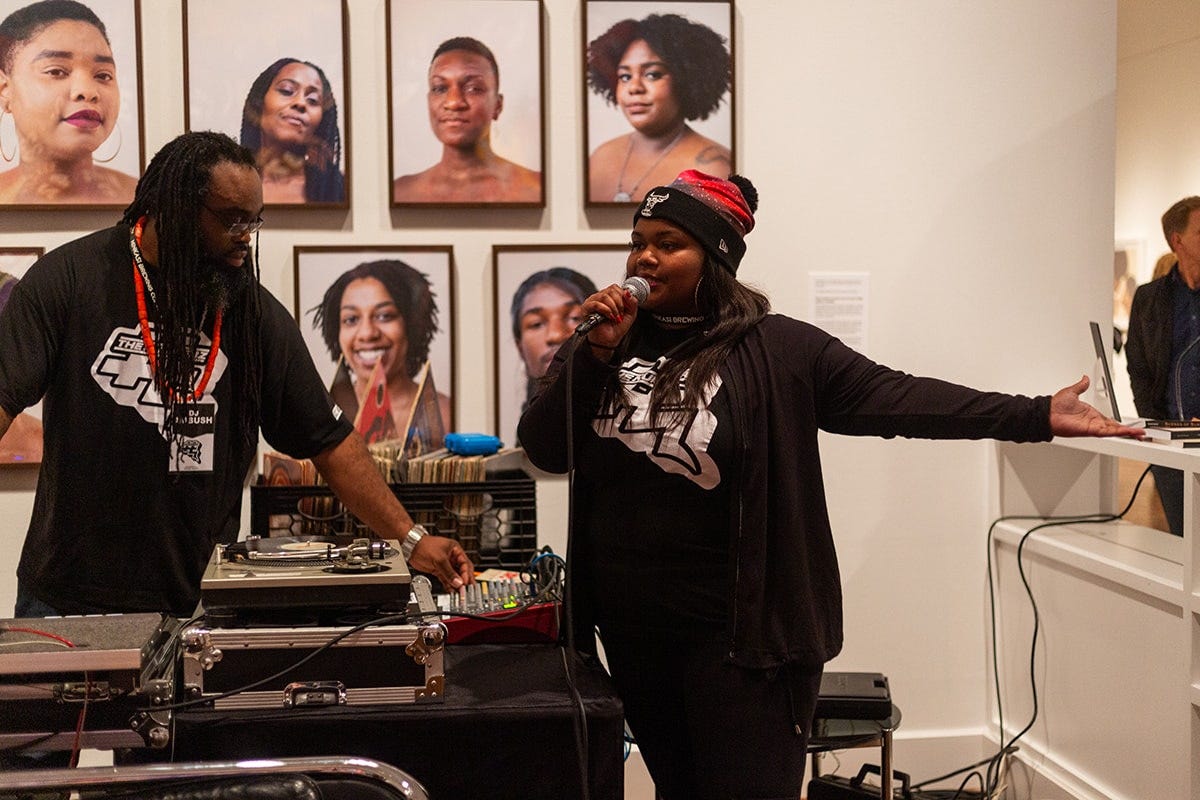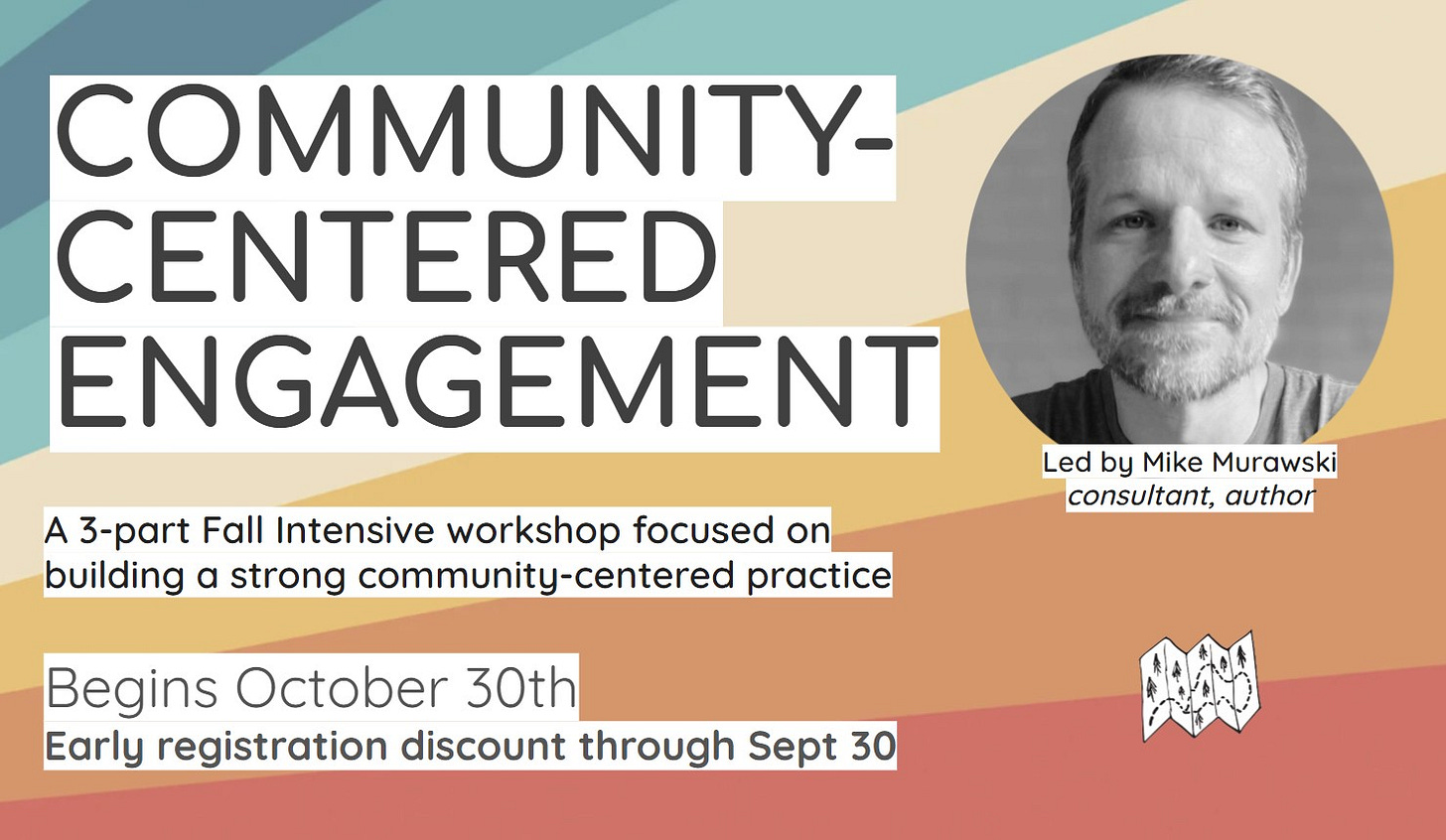Defining what ‘community’ means for us & our organization
Having an important conversation about "community" and its complexities
In so much of the work I do with museums and nonprofits around community engagement, we start with defining what an organization and its staff mean when they say ‘community.’ That’s not as simple and straightforward conversation as it would seem, but it is a really important one!
Next Monday, Sept 30, marks the early registration deadline for the “Community-Centered Engagement” Fall workshop intensive we’re offering (starting October 30). And as I get ready for this fall’s version of this workshop I’ve been reflecting a lot on how vital this first step is.
So I’ve decided to re-share the following post that I first wrote last spring about both how and why the practice of defining community is an essential first step to building meaningful community partnerships and effective engagement strategies.
If this is something you’re needing more support with, considering signing up for this workshop, which is designed to help you build a stronger community-centered practice and advocate for more meaningful community involvement at your organization.
The workshop is already filling up fast, and there’s a really incredible group of people coming together for this.
The post below is adapted from my book Museums as Agents of Change, and I think this can offer some helpful insights and frameworks for anyone beginning this process.
What do we mean when we use the word ‘community’?
Obviously, there is no single definition for the word ‘community.’
And it does not benefit this conversation to check with Webster’s dictionary, since the traditional definition of community is vague and outdated. In his influential book Community: The Structure of Belonging (2008), Peter Block offers an exploration of community building and the ways that healthy, restorative communities emerge and sustain themselves. Defining community as the experience of belonging, Block writes:
“We are in a community each time we find a place where we belong.”
This core sense of belonging is about being a part of something bigger than just ourselves, and about having a sense of ownership of that community.
First and foremost, then, community is about people. At the core of this idea of ‘community’ is a set of human relationships, not just a place, a neighborhood, a demographic, an organization, or internet platform.
Second, it is important to recognize that people participate and identify with multiple communities at the same time. We might belong to a church, feel affinity to people in our neighborhood, be connected with those at our school, and bond with others who share an aspect of our personal identity (age, sexuality, ethnicity, language, etc.)—all on the same day. We all belong to many communities, some that we define for ourselves and some that are defined for us. Our participation in certain communities might be deep, long-term, and really meaningful to us, while our involvement in other communities might be fairly thin and insignificant.

It’s also important to note that the social relationships that form communities are fluid, constantly shifting given time and changing circumstances. While it seems obvious that formal institutions (schools, churches, museums, and non-profits) play an important role in forming communities, we also need to recognize the powerful role of informal institutions (a local grocery co-op, a community choir group, a book club, or a community garden). Through each of these communities, we might come together to feel various degrees of shared belonging, trust, connection, mutual interests, and safety.
On top of these ways to define community, I want to layer on the transformative belief in a ‘beloved community’ that comes from the teachings of Martin Luther King, Jr., as well as important writings by Grace Lee Boggs and bell hooks. It is the idea of community as an agent of change, engaged in the struggle for justice and the well-being of the whole. In her book Killing Rage: Ending Racism (1996), hooks writes:
“Beloved community is formed not by the eradication of difference but by its affirmation, by each of us claiming the identities and cultural legacies that shape who we are and how we live in the world.”
This affirmative vision of community is based, in part, upon finding common ground through social justice and the possibility of radical change as well as the transformative element of shared responsibility. Community is not merely a passive gathering of people around shared interests or shared geography, but rather the form through which these shared understandings take on life as collective action.
This more active notion of community, or building community, also connects deeply to the concept of ‘bridging’ popularized by Robert Putnam, author of Bowling Alone: The Collapse and Revival of American Community (2000). In this groundbreaking book that has been part of the conversations in museums for many years, Putnam examines how we might begin to strengthen a sense of connection through social networks and building social capital. While one form of social capital is created through “bonding” among homogenous, exclusive, inward-facing groups, another more powerful form of social capital is created through “bridging” diverse, heterogeneous, inclusive, and outward-looking groups through activities of sharing, exchange, and consensus building.
The Better Together report, published by the Saguaro Seminar, takes a look at the role of the arts and museums in successfully building social capital in the United States. Elizabeth Crooke discusses this report in her fantastic book entitled Museums and Community (2007), in which she describes in more detail the various concepts of social capital.
The Saguaro report argues that arts and culture organizations can nurture connectedness and bridging by “strengthening friendships, helping communities to understand and celebrate their heritage, and providing safe ways to discuss and solve difficult social problems.” Overall, the report recommended key principles to guide the arts, including to encourage initiatives that “form bridges across race, income, gender, religion, and generations” as well as including arts and culture in community planning and organizing.
The concepts of beloved community and the social capital of bridging both celebrate difference, and work toward bringing people together to form and strengthen new relationships. Overlap these defining characteristics of community with the ideas of a human-centered museum, and we find deep commonalities of human connection, social relationships, and a commitment to change.
For me, these overarching ideas form the basis for any productive discussion of community and how we then work to specifically identify a community of interest and build an institution’s connection and relationship with that community.
As Elizabeth Crooke so perfectly writes:
“To be of value, museums need to find significance within these communities—without those connections, the museum and its collections will be of little importance. It is people who bring the value and consequence to objects and collections; as a result, if a museum cannot forge associations with people, it will have no meaning.” (131)

How can we begin to value community?
When museums begin to develop meaningful relationships with certain communities, they must understand the power dynamics involved. Most museums hold a great deal of institutional power and authority, so many relationships or partnerships with community groups begin in a situation of imbalance and inequity.
In her introduction to Museums and their Communities, Sheila Watson recognizes that museums are understood “to represent those who have privileges in society, i.e., the educated, the relatively wealthy, those who are in control through either their status … or through direct political power.” This power extends to a museum’s architecture, collections and collecting practices, exhibitions, scholarship, and interpretation.
It is also important to recognize the tension in most museums between traditional academic scholarship and community input. Consulting with community knowledge holders can often be viewed as an erosion of scholarship and curatorial confidence, and working with community-based artists can be seen as lowering accepted standards of ‘quality.’ On top of all of this baggage, the Western colonial concept of the museum itself may not necessarily be relevant or valued in many communities who have been excluded or oppressed by this system.
For community relationships to grow and thrive, museums need to step back from their role as authorities and see community members as experts, leaders, and valuable sources of knowledge, stories, and lived experience. Identifying community power and valuing resident and citizen participation works to ensure the agency of community members and legitimize these partnerships. Stacey Garcia, leading thinker in museums and part of the team at the International Coalition of Sites of Conscience, has both researched and enacted community and civic engagement practices, methods, and theories in museums. In a post for Museum 2.0, Garcia wrote these words that powerfully flips the script on traditional forms of community engagement in museums:
“It’s not solely about how museums can serve communities but rather what are the communities’ resources, knowledge and interests that can inform museum practice? Furthermore, how can museums and communities work together to share strengths in the community?”
Quick Deadline Reminder
Just one week left to sign up at a discount! As a reminder, the Intensive has an early registration discount (use the code: EARLYBIRD) if you register by Monday, September 30.
And as always, I am happy to discuss additional support with a check-in meeting for those who might not be able to every workshop. So if you are thinking about joining but have scheduling conflicts, or if you have any other questions at all, please don’t hesitate to contact me at murawski27@gmail.com!
Did you know that Agents of Change has a paid subscription option? Paid subscribing gives you access to additional posts. It’s also a way to support the work it takes to create this Substack (thank you!!).
And if you are curious to know more about some of the different kinds of services I do - including the creative work I do with nature and place-based arts nonprofits, have a look at my project page and services page.


